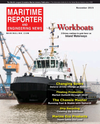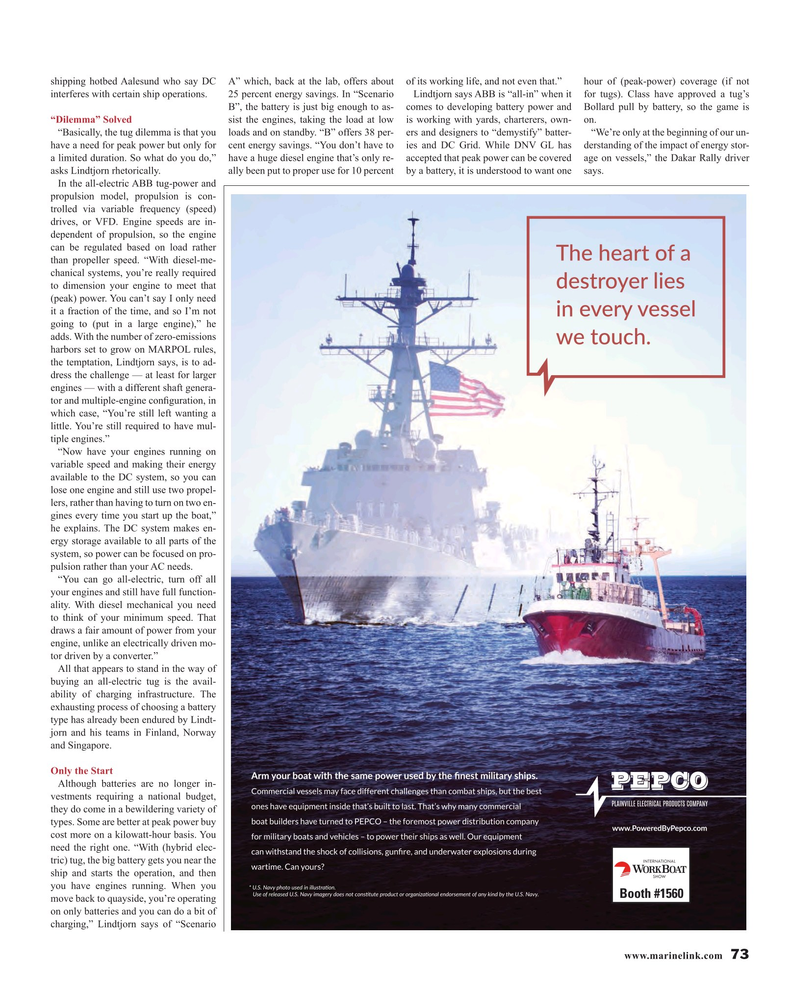
Page 73: of Maritime Reporter Magazine (November 2015)
Workboat Edition
Read this page in Pdf, Flash or Html5 edition of November 2015 Maritime Reporter Magazine
shipping hotbed Aalesund who say DC A” which, back at the lab, offers about of its working life, and not even that.” hour of (peak-power) coverage (if not interferes with certain ship operations. 25 percent energy savings. In “Scenario Lindtjorn says ABB is “all-in” when it for tugs). Class have approved a tug’s
B”, the battery is just big enough to as- comes to developing battery power and Bollard pull by battery, so the game is “Dilemma” Solved sist the engines, taking the load at low is working with yards, charterers, own- on. “Basically, the tug dilemma is that you loads and on standby. “B” offers 38 per- ers and designers to “demystify” batter- “We’re only at the beginning of our un- have a need for peak power but only for cent energy savings. “You don’t have to ies and DC Grid. While DNV GL has derstanding of the impact of energy stor- a limited duration. So what do you do,” have a huge diesel engine that’s only re- accepted that peak power can be covered age on vessels,” the Dakar Rally driver asks Lindtjorn rhetorically. ally been put to proper use for 10 percent by a battery, it is understood to want one says.
In the all-electric ABB tug-power and propulsion model, propulsion is con- trolled via variable frequency (speed) drives, or VFD. Engine speeds are in- dependent of propulsion, so the engine can be regulated based on load rather
The heart of a than propeller speed. “With diesel-me- chanical systems, you’re really required destroyer lies to dimension your engine to meet that (peak) power. You can’t say I only need it a fraction of the time, and so I’m not in every vessel going to (put in a large engine),” he adds. With the number of zero-emissions we touch.
harbors set to grow on MARPOL rules, the temptation, Lindtjorn says, is to ad- dress the challenge — at least for larger engines — with a different shaft genera- tor and multiple-engine con? guration, in which case, “You’re still left wanting a little. You’re still required to have mul- tiple engines.” “Now have your engines running on variable speed and making their energy available to the DC system, so you can lose one engine and still use two propel- lers, rather than having to turn on two en- gines every time you start up the boat,” he explains. The DC system makes en- ergy storage available to all parts of the system, so power can be focused on pro- pulsion rather than your AC needs.
“You can go all-electric, turn off all your engines and still have full function- ality. With diesel mechanical you need to think of your minimum speed. That draws a fair amount of power from your engine, unlike an electrically driven mo- tor driven by a converter.”
All that appears to stand in the way of buying an all-electric tug is the avail- ability of charging infrastructure. The exhausting process of choosing a battery type has already been endured by Lindt- jorn and his teams in Finland, Norway and Singapore.
Only the Start ul?o?u0o-|?b|_|_;v-l;ro?;u?v;70?|_;Cm;v|lb?b|-u?v_brvl
Although batteries are no longer in-
Commercial vessels may face different challenges than combat ships, but the best vestments requiring a national budget,
PLAINVILLE ELECTRICAL PRODUCTS COMPANY ones have equipment inside that’s built to last. That’s why many commercial they do come in a bewildering variety of boat builders have turned to PEPCO – the foremost power distribution company types. Some are better at peak power buy ???lo?;u;7?;r1ol1ol cost more on a kilowatt-hour basis. You for military boats and vehicles – to power their ships as well. Our equipment need the right one. “With (hybrid elec-
GER[MXLWXERHXLIWLSGOSJGSPPMWMSRWKYRcVIERHYRHIV[EXIVI\TPSWMSRWHYVMRK tric) tug, the big battery gets you near the wartime. Can yours? ship and starts the operation, and then you have engines running. When you
R&?"?-??r_o|o?v;7bmb???v|u-?om? &v;o=u;?;-v;7&?"?-??bl-];u?7o;vmo|1omv?|?|;ruo7?1|ouou]-mb?-?om-?;m7ouv;l;m|o=-m?hbm70?|_;&?"?-???
Booth #1560 move back to quayside, you’re operating on only batteries and you can do a bit of charging,” Lindtjorn says of “Scenario www.marinelink.com 73
MR #11 (66-73).indd 73 11/2/2015 4:31:57 PM

 72
72

 74
74
